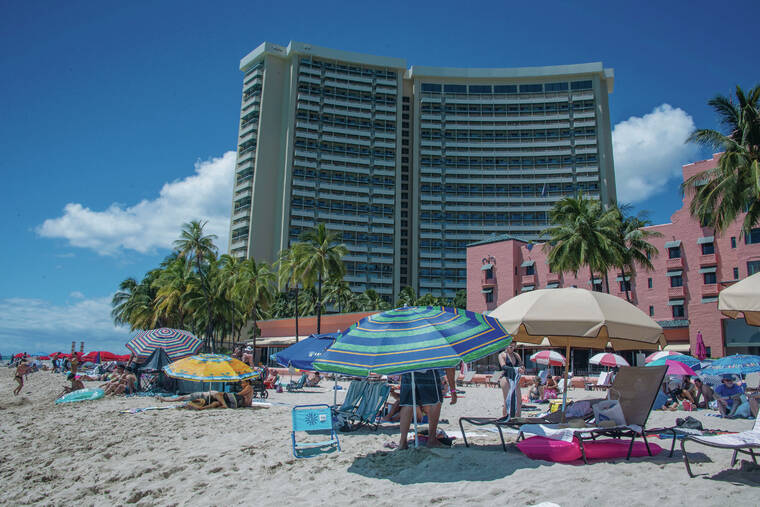
Mahalo for supporting Honolulu Star-Advertiser. Enjoy this free story!
Hawaii hotels are looking to fill thousands of jobs statewide as the hospitality industry, one of Hawaii’s top economic drivers, continues a recovery this year that’s projected to surpass 2019’s pre-pandemic levels.
The American Hotel & Lodging Association joined hospitality, government and business leaders from the Hawaii Hotel Alliance, Outrigger Hospitality Group and the Hawaii House Finance Committee on Wednesday to discuss the labor shortage and how it, coupled with surging travel demand, is creating historic opportunities for hotel employees.
AHLA president and CEO Chip Rogers, who spoke at the Outrigger Reef, which hosted the event, said there are more than 500 hotel jobs open in Honolulu and upward of 1,600 statewide are listed on Indeed.com alone.
“People just are not coming back to work. The national workforce participation rate is at a multidecade low. Young people are starting their careers later, older people tend to be leaving the workforce sooner,” Rogers said. While the hiring challenges are many, Rogers said so too are opportunities for workers at a time when hotels are willing to do what it takes to recruit and keep them.
“You can start today at a higher wage than ever before with better benefits, better flexibility — and have that opportunity to move up more quickly than we’ve ever seen,” he said.
The aggressive push to fill these jobs comes as Hawaii tourism winds up a busy summer, moves toward the festive season and prepares for return of business travel. It also follows a round of hotel union contract negotiations, many of which restore daily housekeeping and protect workers against automation-related job losses, said Unite Here Local 5 spokesman Bryant de Venecia.
Daily housekeeping, de Venecia said, returned to the Hilton Hawaiian Village on Sept. 5. On Wednesday, workers at Hawaii’s Kyo-ya and Marriott properties were voting on a contract that would restore daily housekeeping. He said daily housekeeping, which was halted at many hotels at the height of COVID-19 protocols, is expected to return to nearly all Unite Here Local 5 hotels after this contract season.
AHLA said Hawaii hotels’ 2022 leisure and business travel revenue tallies are expected to surpass 2019 levels. According to an analysis for AHLA by Kalibri Labs, Hawaii hotels’ 2022 leisure travel revenue is projected to be $3.9 billion, versus $3.8 billion in 2019; and Hawaii hotels’ 2022 business travel revenue is projected to be $1.7 billion, versus $1.5 billion in 2019.
To fully realize those gains, Rogers said, labor shortages must not interfere with economic expansion. When the workforce was even tighter, Rogers said, some hotels had to resort to taking rooms out of supply or not biding on larger conferences.
The labor shortage, meanwhile, has afforded some hotel workers with more bargaining power than they have had in the past. Hawaii Hotel Alliance president Jerry Gibson said the average hotel barista in Hawaii makes about $23 an hour and tips ranging from $25 to $75 a day with a benefits package that often includes a retirement pension, medical, a free daily meal, and vacation, including some free hotel nights.
Rogers added that some hotels are offering new perks, such as flexible shifts and an option for worker to get paid daily to compete with the gig economy, in which workers with services like Uber are paid almost instantly.
Scaling up hotel workers hasn’t been as easy as reopening for business, and Hawaii hotels have a lot of ground to make up. There were 44,273 direct jobs at Hawaii hotels in 2019 — and by 2021 they had fallen to 31,419, a 29% job loss, according to an analysis that Oxford Economics prepared for AHLA.
Recovery for Hawaii’s hotels is still somewhat uneven, though the overall outlook is promising. In July, Kauai, Hawaii island and Maui had achieved almost full recovery in the category of arrivals by air. Oahu, Molokai and Lanai still have a ways to go toward that goal.
Gibson said travel from Asia, which supplied anywhere from 18 to 22% of Oahu’s pre-pandemic business, is still lagging as is statewide group business.
Jeff Wagoner, Outrigger Hospitality Group president and CEO, said Hawaii’s hotels have been eagerly awaiting the opportunity to host more events, businesses and families.
“That opportunity is finally here, and Honolulu hotels and resorts are ready,” Wagoner said. “The continued success of the hotel industry — especially as we bounce back from the pandemic — means greater success for our workforce, their families and all of Honolulu.”
Most workers from Hawaii’s largest hotel union, Unite Here Local 5, who were sidelined by the pandemic but elected to go back to work, have been able to do so, de Venecia said. However, there are simply fewer workers available now, and retention has sometimes been difficult, especially when not all of the jobs are offering 40-hour weeks, he said.
“We had about 9,000 hotel workers before the pandemic, now we have about 8,000,” de Venecia said. “During the downturn, some workers left Hawaii for the U.S. mainland. Some of those who were eligible to retire did so. Some aren’t getting their hours, so they’ve taken other jobs sometimes in other industries.”
Alissa Tamayo, a food beverage worker at the Moana Surfrider, said the labor picture is complicated. Her hotel hasn’t fully reopened all the food and beverage venues that it closed during the pandemic. Consequently, staffing is affected. She said labor shortages are also evident at times when the hotel’s occupancy is high or there are special functions.
Tamayo said for most of the 31 years that she has worked at the hotel she has gotten paid for 80 hours every two weeks. During the last 22 months, her two-week pay periods have teetered between 54 and 62 hours.
”It’s been a complete lifestyle change. It’s an absolute struggle every day,” said Tamayo, a single parent, who has had to dip into savings to make ends meet.
Tamayo said during the height of the pandemic less-senior workers have been getting even fewer hours, which is one of the reasons that new hires sometimes leave.
Such workplace experiences are echoed by workers included in the so-called Great Resignation — a nationwide trend that also has taken root in Hawaii. U.S. Labor Department data shows that for the past year more than 4 million workers each month have quit their jobs. The department’s July data, the most recent available, showed that the number and rate of those quitting were little changed at 4.2 million and 2.7%, respectively.
The quit rate is the number of those quitting during the entire month as a percent of total employment.
Nationwide quit rates in July were the highest for accommodations and food services, which was at 5.6%, and leisure and hospitality, which was at 5.3%. These numbers were unchanged from June.
———
The Associated Press contributed to this story.
Read More: World News | Entertainment News | Celeb News
Star Ads






